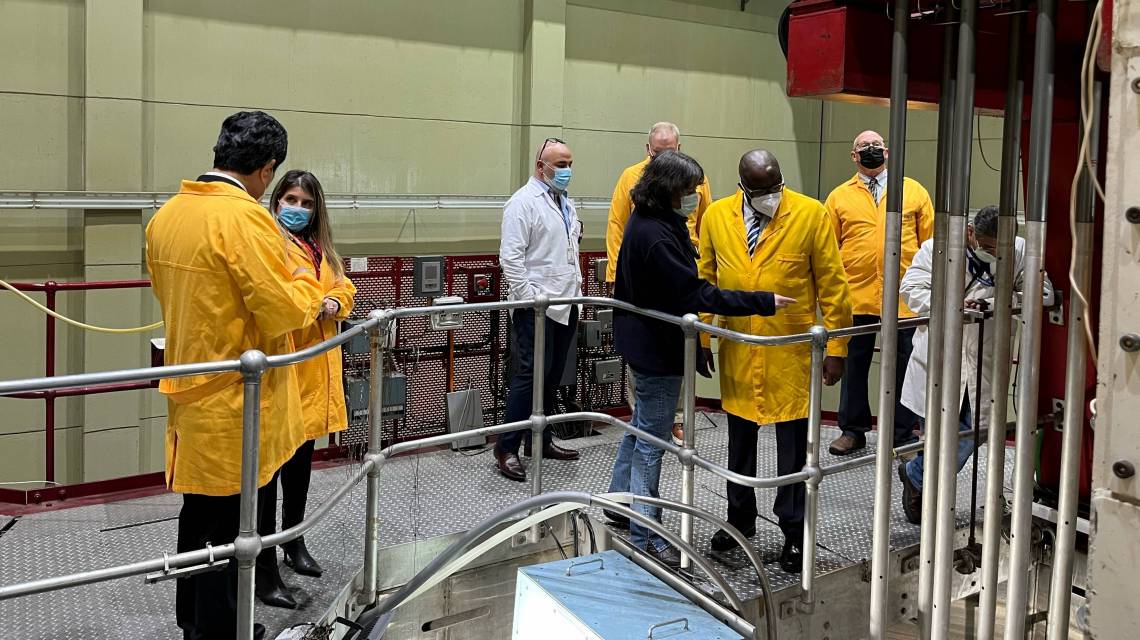An international team of experts completed the first IAEA Integrated Research Reactor Utilization Review (IRRUR) mission this month, carried out on the 5MW pool-type RECH-1 research reactor at the La Reina Nuclear Centre in Santiago, Chile. The IRRUR is a new IAEA review service, developed to assist countries in enhancing the utilization and sustainability of nuclear research reactor facilities. This mission, which took place from 4 to 8 July, followed a request from the Chilean Nuclear Energy Commission (CChEN).
Five experts from Belgium, Argentina, the United States, the IAEA and an observer from Peru in advance of the IRRUR mission taking place in Peru in August, joined the five-day mission. They carried out a thorough assessment of the way in which the RECH-1 research reactor is currently being used and its potential capabilities. They identified further utilization areas and feasible areas of research and development that the reactor can be used for and products and services that it can provide.
"The mission team found that there are many opportunities for expanded utilization of the RECH-1 reactor," said Nuno Pessoa Barradas, an IAEA research reactor specialist leading the mission. "Therefore, one key recommendation is to develop and implement an outreach strategy for the reactor, as this will greatly help to expand its user community."
Research reactors, unlike nuclear power plants, generate primarily neutrons rather than power, and are used for research, development, education and training purposes. They play a vital role across several fields, producing radioisotopes used in medicine, industry and agriculture. According to the IAEA Research Reactor Database, 223 research reactors are now in operation in 53 countries, and 24 new research reactor programmes are under planning and development.
Planning for the IRRUR mission in Chile began in July 2021, with a preparation mission for the RECH-1 research reactor conducted virtually by a team, followed by a virtual mission in December, due to COVID-19-related travel limitations. At that stage, the team provided a series of recommendations for the research reactor, one of which - the development of a neutron imaging system - has already been implemented with assistance from IAEA technical cooperation.
"With the new setup, neutron imaging could be more affordable and therefore more feasible for the reactor to develop, which opens new lines of research at the reactor," said Lin-wen Hu, Senior Research Scientist at the Massachusetts Institute of Technology's Nuclear reactor Laboratory, who took part in the mission. Neutron imaging, similar to x-ray radiography, is a non-destructive way of identifying the internal structure of manufactured items such as cultural heritage objects. Since the neutron imaging system was installed in June this year, tests have been carried out and the first neutron radiography has been produced.
Following the review mission this week, the team concluded that Chile is making progress in strengthening the utilization of the research reactor. They recommended, among other actions, the establishment of partnerships with stakeholders in the area of medical radioisotopes to identify those of interest for the country and forecast for future needs. The team also recommended initiating a research and development programme based on neutron beams, starting with utilization of the neutron imaging setup.
"Nuclear sciences and technologies contribute to national development goals in health, environment, water and agricultural resources, energy, mining, industry, among others," said Luis Huerta, Executive Director of CChEN. "These IAEA missions, with the objective of an exhaustive review of the Chilean nuclear reactor RECH-1, provide the analysis of our capabilities and capacities, in order to improve the operation and maintenance and expand the use and applications of our nuclear facility, especially for new research and development initiatives."
During the same week, for the first time, an IAEA Operation and Maintenance Assessment for Research Reactors (OMARR) mission was carried out jointly with IRRUR on the RECH-1 research reactor. OMARR missions are designed to assist countries in improving operational and maintenance practices, communications and in-service inspections, and to assist in establishing an ageing management programme towards improving their research reactor availability and reliability while extending the operating lifetime. The OMARR mission was carried out by a team of five international experts, from Argentina, the Netherlands, South Africa and the United States, held discussions with staff and managers of the CChEN and provided advice and recommendations on relevant topics.
"We are very pleased with the synergy achieved by bringing together the two expert teams and the local operating staff towards a better understanding of the opportunities and constraints," said Ruben Mazzi, leader of the IAEA's expert team for the OMARR mission. "Implementing the recommendations of the OMARR mission will assist CChEN in its efforts to ensure the safe effective and reliable operation of the RECH-1, which is an essential condition towards the sustainable increase of the reactor utilization for benefiting Chilean community in the next decades."
The IAEA offers several peer review services related to research reactors, including IRRUR, OMARR, the Integrated Safety Assessment of Research Reactors (INSARR) and the Integrated Nuclear Infrastructure Review for a new Research Reactor (INIR-RR). The IAEA also provides guidelines for reviewing the safety, and assessing the operation and maintenance of, research reactors. The IAEA's guidelines on IRRUR will be published at the end of this year. In 2020, the Agency launched an e-learning course, providing training on strategic planning for enhancing the utilization of research reactors.
Five more IRRUR missions have been planned for 2022 to 2023. Following the completed review mission in Chile, three missions will be conducted in countries in Latin American, African and Asia Pacific this year, and two are planned in the United States in 2023.







